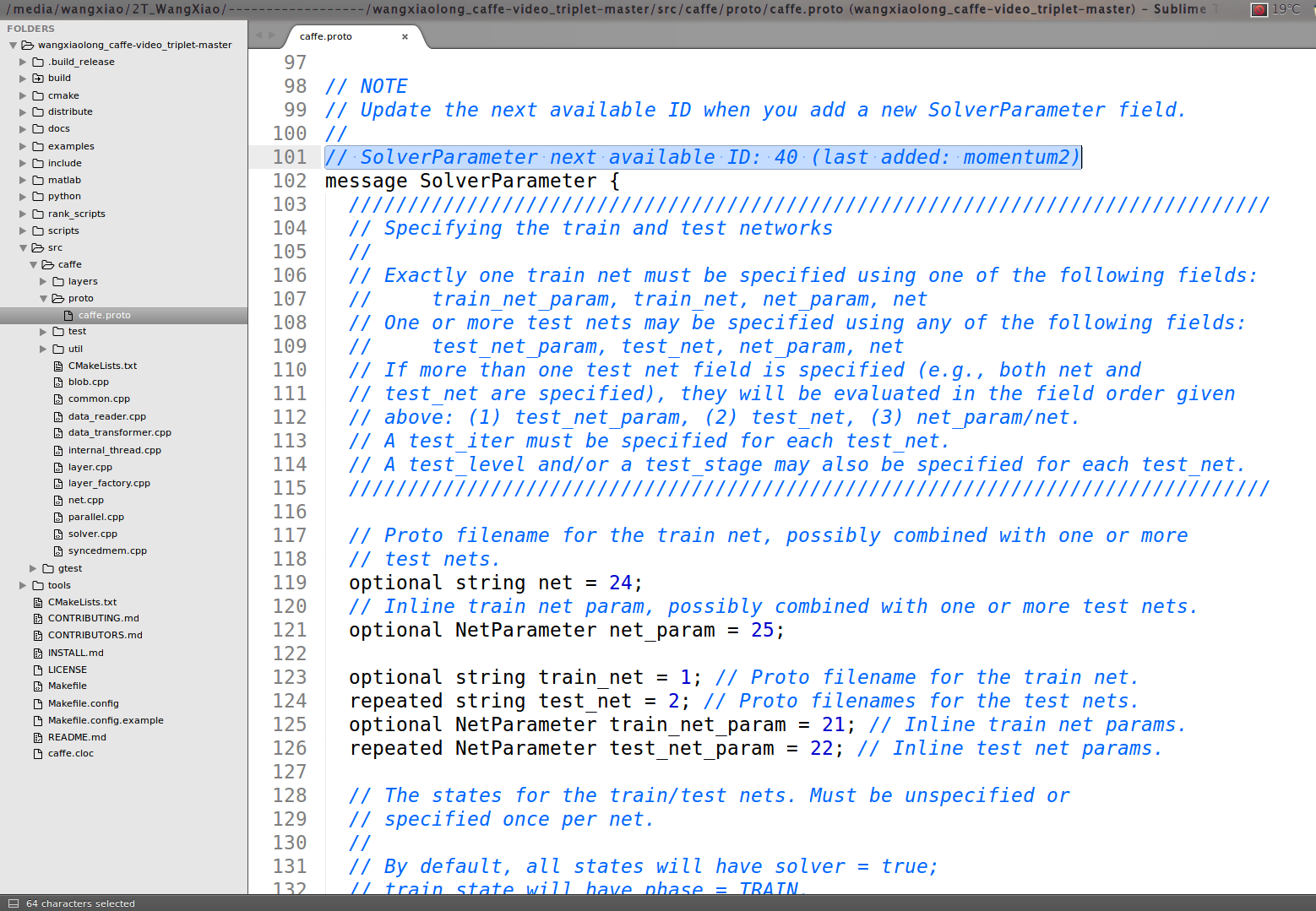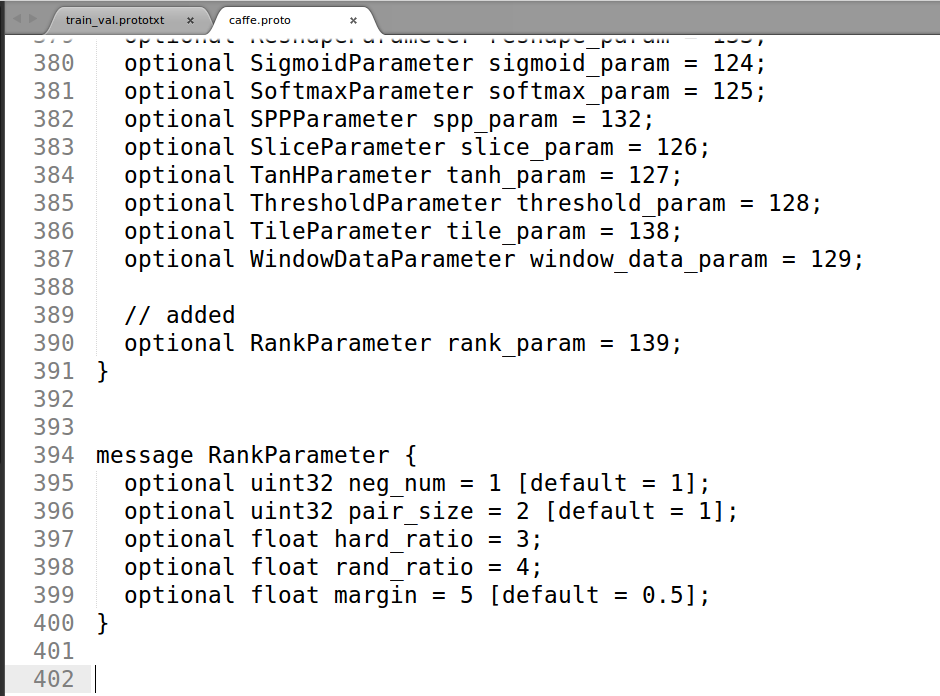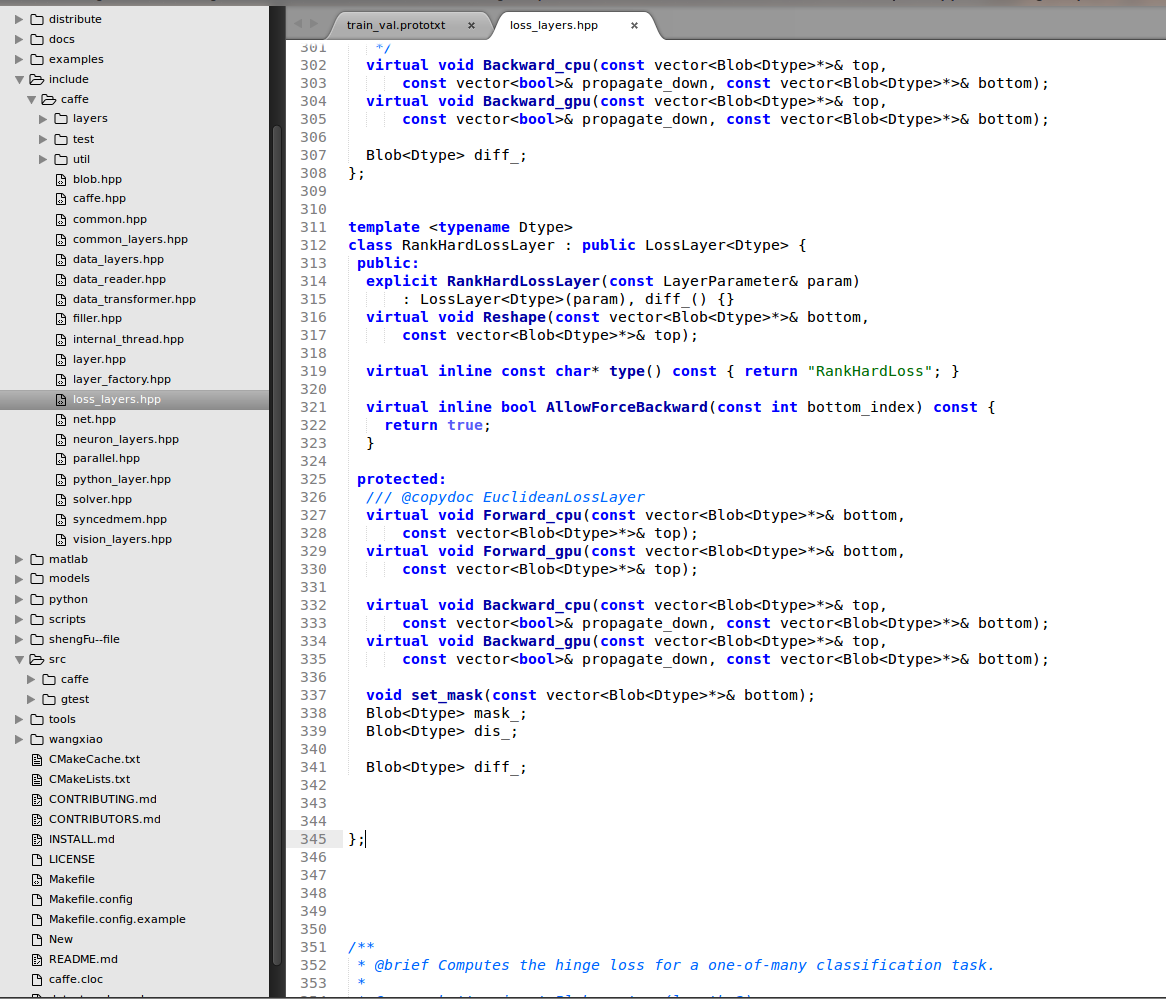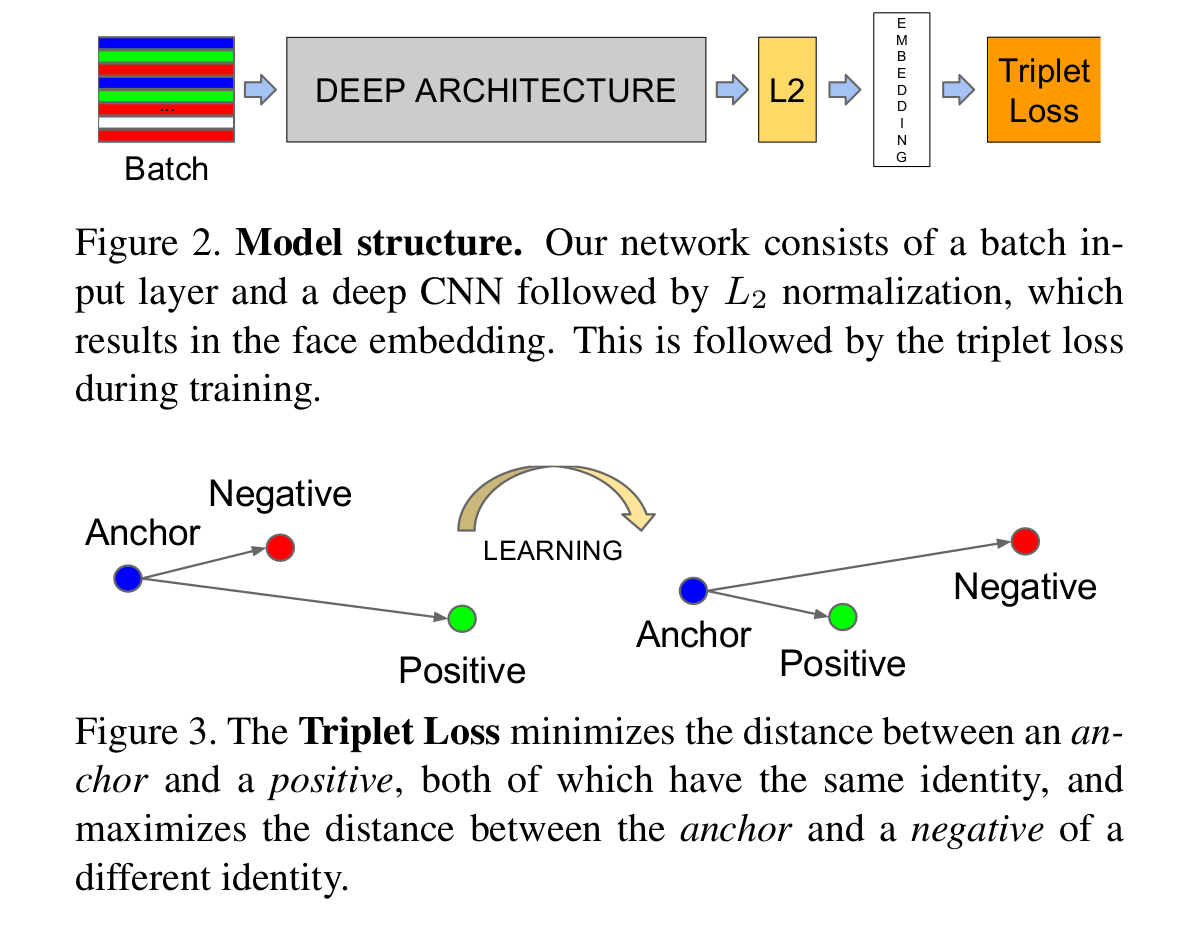Tutorial: Triplet Loss Layer Design for CNN
Tutorial: Triplet Loss Layer Design for CNN
Xiao Wang 2016.05.02
Triplet Loss Layer could be a trick for further improving the accuracy of CNN. Today, I will introduce the whole process, and display the code for you. This tutorial mainly from the blog:
http://blog.csdn.net/tangwei2014/article/details/46812153
http://blog.csdn.net/tangwei2014/article/details/46788025
and the paper: <FaceNet: A Unified Embedding for Face Recognition and Clustering>.
First, Let's talk about how to add the layer into caffe and make test this layer to check whether it works or not. And then, we will discuss the paper and introduce the process of how the triplet loss come from. In the new version of caffe framework, it mainly consists of these steps for add a new layer i.e.
step 1. add the paprameter message in the corresponding layer, which located in ./src/caffe/proto/caffe.proto ;
step 2. add the declaration information of the layer in ./include/caffe/***layers.hpp ;
step 3. add the corresponding .cpp and .cu files in ./src/caffe/layers/, realize the function of the new added layer;
step 4. add test code of new added layers in ./src/caffe/gtest/, test its foreward and back propagation and its computation speed.
Let's do it step by step.
First, we add triplet loss layer in caffe.proto file:
we could found that in line 101, it said: SolverParameter next available ID: 40 (last added: momentum2), thus we add the ID: 40 as the new added information :
message RankParameter {
optional uint32 neg_num = 1 [default = 1];
optional uint32 pair_size = 2 [default = 1];
optional float hard_ratio = 3;
optional float rand_ratio = 4;
optional float margin = 5 [default = 0.5];
}


Second, we add the declearation information about triplet loss layer in ./include/caffe/TripletLoss_layers.hpp

Third, We compile the triplet loss layer of .cpp and .cu file
First of all is the .cpp file
#include <vector> #include <algorithm>
#include <cmath>
#include <cfloat> #include "caffe/layer.hpp"
#include "caffe/util/io.hpp"
#include "caffe/util/math_functions.hpp"
#include "caffe/vision_layers.hpp" using std::max;
using namespace std;
using namespace cv; namespace caffe { int myrandom (int i) { return caffe_rng_rand()%i;} template <typename Dtype>
void RankHardLossLayer<Dtype>::Reshape(
const vector<Blob<Dtype>*>& bottom, const vector<Blob<Dtype>*>& top) {
LossLayer<Dtype>::Reshape(bottom, top); diff_.ReshapeLike(*bottom[]);
dis_.Reshape(bottom[]->num(), bottom[]->num(), , );
mask_.Reshape(bottom[]->num(), bottom[]->num(), , );
} template <typename Dtype>
void RankHardLossLayer<Dtype>::set_mask(const vector<Blob<Dtype>*>& bottom)
{ RankParameter rank_param = this->layer_param_.rank_param();
int neg_num = rank_param.neg_num();
int pair_size = rank_param.pair_size();
float hard_ratio = rank_param.hard_ratio();
float rand_ratio = rank_param.rand_ratio();
float margin = rank_param.margin(); int hard_num = neg_num * hard_ratio;
int rand_num = neg_num * rand_ratio; const Dtype* bottom_data = bottom[]->cpu_data();
const Dtype* label = bottom[]->cpu_data();
int count = bottom[]->count();
int num = bottom[]->num();
int dim = bottom[]->count() / bottom[]->num();
Dtype* dis_data = dis_.mutable_cpu_data();
Dtype* mask_data = mask_.mutable_cpu_data(); for(int i = ; i < num * num; i ++)
{
dis_data[i] = ;
mask_data[i] = ;
} // calculate distance
for(int i = ; i < num; i ++)
{
for(int j = i + ; j < num; j ++)
{
const Dtype* fea1 = bottom_data + i * dim;
const Dtype* fea2 = bottom_data + j * dim;
Dtype ts = ;
for(int k = ; k < dim; k ++)
{
ts += (fea1[k] * fea2[k]) ;
}
dis_data[i * num + j] = -ts;
dis_data[j * num + i] = -ts;
}
} //select samples vector<pair<float, int> >negpairs;
vector<int> sid1;
vector<int> sid2; for(int i = ; i < num; i += pair_size)
{
negpairs.clear();
sid1.clear();
sid2.clear();
for(int j = ; j < num; j ++)
{
if(label[j] == label[i])
continue;
Dtype tloss = max(Dtype(), dis_data[i * num + i + ] - dis_data[i * num + j] + Dtype(margin));
if(tloss == ) continue; negpairs.push_back(make_pair(dis_data[i * num + j], j));
}
if(negpairs.size() <= neg_num)
{
for(int j = ; j < negpairs.size(); j ++)
{
int id = negpairs[j].second;
mask_data[i * num + id] = ;
}
continue;
}
sort(negpairs.begin(), negpairs.end()); for(int j = ; j < neg_num; j ++)
{
sid1.push_back(negpairs[j].second);
}
for(int j = neg_num; j < negpairs.size(); j ++)
{
sid2.push_back(negpairs[j].second);
}
std::random_shuffle(sid1.begin(), sid1.end(), myrandom);
for(int j = ; j < min(hard_num, (int)(sid1.size()) ); j ++)
{
mask_data[i * num + sid1[j]] = ;
}
for(int j = hard_num; j < sid1.size(); j++)
{
sid2.push_back(sid1[j]);
}
std::random_shuffle(sid2.begin(), sid2.end(), myrandom);
for(int j = ; j < min( rand_num, (int)(sid2.size()) ); j ++)
{
mask_data[i * num + sid2[j]] = ;
} } } template <typename Dtype>
void RankHardLossLayer<Dtype>::Forward_cpu(const vector<Blob<Dtype>*>& bottom,
const vector<Blob<Dtype>*>& top) { const Dtype* bottom_data = bottom[]->cpu_data();
const Dtype* label = bottom[]->cpu_data();
int count = bottom[]->count();
int num = bottom[]->num();
int dim = bottom[]->count() / bottom[]->num(); RankParameter rank_param = this->layer_param_.rank_param();
int neg_num = rank_param.neg_num(); //
int pair_size = rank_param.pair_size(); //
float hard_ratio = rank_param.hard_ratio();
float rand_ratio = rank_param.rand_ratio();
float margin = rank_param.margin();
Dtype* dis_data = dis_.mutable_cpu_data();
Dtype* mask_data = mask_.mutable_cpu_data(); set_mask(bottom);
Dtype loss = ;
int cnt = neg_num * num / pair_size * ; for(int i = ; i < num; i += pair_size)
{
for(int j = ; j < num; j++)
{
if(mask_data[i * num + j] == )
continue;
Dtype tloss1 = max(Dtype(), dis_data[i * num + i + ] - dis_data[i * num + j] + Dtype(margin));
Dtype tloss2 = max(Dtype(), dis_data[i * num + i + ] - dis_data[(i + ) * num + j] + Dtype(margin));
loss += tloss1 + tloss2;
}
} loss = loss / cnt;
top[]->mutable_cpu_data()[] = loss;
} template <typename Dtype>
void RankHardLossLayer<Dtype>::Backward_cpu(const vector<Blob<Dtype>*>& top,
const vector<bool>& propagate_down, const vector<Blob<Dtype>*>& bottom) { const Dtype* bottom_data = bottom[]->cpu_data();
const Dtype* label = bottom[]->cpu_data();
Dtype* bottom_diff = bottom[]->mutable_cpu_diff();
int count = bottom[]->count();
int num = bottom[]->num();
int dim = bottom[]->count() / bottom[]->num(); RankParameter rank_param = this->layer_param_.rank_param();
int neg_num = rank_param.neg_num();
int pair_size = rank_param.pair_size();
float hard_ratio = rank_param.hard_ratio();
float rand_ratio = rank_param.rand_ratio();
float margin = rank_param.margin(); Dtype* dis_data = dis_.mutable_cpu_data();
Dtype* mask_data = mask_.mutable_cpu_data(); for(int i = ; i < count; i ++ )
bottom_diff[i] = ; int cnt = neg_num * num / pair_size * ; for(int i = ; i < num; i += pair_size)
{
const Dtype* fori = bottom_data + i * dim;
const Dtype* fpos = bottom_data + (i + ) * dim; Dtype* fori_diff = bottom_diff + i * dim;
Dtype* fpos_diff = bottom_diff + (i + ) * dim;
for(int j = ; j < num; j ++)
{
if(mask_data[i * num + j] == ) continue;
Dtype tloss1 = max(Dtype(), dis_data[i * num + i + ] - dis_data[i * num + j] + Dtype(margin));
Dtype tloss2 = max(Dtype(), dis_data[i * num + i + ] - dis_data[(i + ) * num + j] + Dtype(margin)); const Dtype* fneg = bottom_data + j * dim;
Dtype* fneg_diff = bottom_diff + j * dim;
if(tloss1 > )
{
for(int k = ; k < dim; k ++)
{
fori_diff[k] += (fneg[k] - fpos[k]); // / (pairNum * 1.0 - 2.0);
fpos_diff[k] += -fori[k]; // / (pairNum * 1.0 - 2.0);
fneg_diff[k] += fori[k];
}
}
if(tloss2 > )
{
for(int k = ; k < dim; k ++)
{
fori_diff[k] += -fpos[k]; // / (pairNum * 1.0 - 2.0);
fpos_diff[k] += fneg[k]-fori[k]; // / (pairNum * 1.0 - 2.0);
fneg_diff[k] += fpos[k];
}
} }
} for (int i = ; i < count; i ++)
{
bottom_diff[i] = bottom_diff[i] / cnt;
} } #ifdef CPU_ONLY
STUB_GPU(RankHardLossLayer);
#endif INSTANTIATE_CLASS(RankHardLossLayer);
REGISTER_LAYER_CLASS(RankHardLoss); } // namespace caffe
and the .cu file
#include <vector> #include "caffe/layer.hpp"
#include "caffe/util/io.hpp"
#include "caffe/util/math_functions.hpp"
#include "caffe/vision_layers.hpp" namespace caffe { template <typename Dtype>
void RankHardLossLayer<Dtype>::Forward_gpu(const vector<Blob<Dtype>*>& bottom,
const vector<Blob<Dtype>*>& top) {
Forward_cpu(bottom, top);
} template <typename Dtype>
void RankHardLossLayer<Dtype>::Backward_gpu(const vector<Blob<Dtype>*>& top,
const vector<bool>& propagate_down, const vector<Blob<Dtype>*>& bottom) {
Backward_cpu(top, propagate_down, bottom);
} INSTANTIATE_LAYER_GPU_FUNCS(RankHardLossLayer); } // namespace caffe
Finally, we make the caffe file and check whether have some mistakes about it.
--------------------------------------------------------------------------------------------------------------------------------------------------------------------------------------------------------------------------------------------------------------------------------------------------------------------------------------------

Let's continue to talk about the triplet loss:
Just like the above figure showns, the triplet loss usually have three components, i.e. the anchors, the positive, and the negative. What we are going to do is try to reduce the distance between the archor and the same, and push the different from the anchors.

Thus, the whole loss could be described as following:

Only select triplets randomly may lead to slow converage of the network, and we need to find those hard triplets, that are active and can therefore contribute to improving the model. The following section will give you an explanination about the approach.
Triplet Selection:
There are two appproaches for generate triplets, i.e.
1. Generate triplets offline every n steps, using the most recent newwork checkpoint and computing the argmin and argmax on a subset of the data.
2. Generate the triplets online. This can be done by selecting the hard positive/negative exemplars form within a mini-batch.
This paper use all anchor-positive pairs in a mini-batch while still selecting the hard negatives. the all anchor-positive method was more stable and converaged slightly faster at the begining of training.
The code could refer the github page: https://github.com/wangxiao5791509/caffe-video_triplet
layer {
name: "loss"
type: "RankHardLoss"
rank_param{
neg_num: 4
pair_size: 2
hard_ratio: 0.5
rand_ratio: 0.5
margin: 1
}
bottom: "norml2"
bottom: "label"
}Triplet Loss Implementation using Pytorch:
the following document comes from: https://pytorch.org/docs/stable/nn.html#tripletmarginloss
Creates a criterion that measures the triplet loss given an input tensors x1, x2, x3 and a margin with a value greater than 0. This is used for measuring a relative similarity between samples. A triplet is composed by a, p and n: anchor, positive examples and negative example respectively. The shapes of all input tensors should be (N,D)(N,D).
The distance swap is described in detail in the paper Learning shallow convolutional feature descriptors with triplet losses by V. Balntas, E. Riba et al.
The loss function for each sample in the mini-batch is:
where d(xi,yi)=∥xi−yi∥pd(xi,yi)=‖xi−yi‖p.
| Parameters: |
|
|---|
- Shape:
-
- Input: (N,D)(N,D) where D is the vector dimension.
- Output: scalar. If reduce is False, then (N).
>>> triplet_loss = nn.TripletMarginLoss(margin=1.0, p=2)
>>> input1 = torch.randn(100, 128, requires_grad=True)
>>> input2 = torch.randn(100, 128, requires_grad=True)
>>> input3 = torch.randn(100, 128, requires_grad=True)
>>> output = triplet_loss(input1, input2, input3)
>>> output.backward()
Example:
import torch.nn as nn
triplet_loss = nn.TripletMarginLoss(margin=1.2, p=2)
# 计算特征向量
anchor = model.forward(data[0])
positive = model.forward(data[1])
negative = model.forward(data[2])
# 计算三元组loss
loss = triplet_loss.forward(anchor, positive, negative)
loss.backward()
optimizer.step()
Tutorial: Triplet Loss Layer Design for CNN的更多相关文章
- 怎样在caffe中添加layer以及caffe中triplet loss layer的实现
关于triplet loss的原理.目标函数和梯度推导在上一篇博客中已经讲过了.详细见:triplet loss原理以及梯度推导.这篇博文主要是讲caffe下实现triplet loss.编程菜鸟.假 ...
- 论文笔记之: Person Re-Identification by Multi-Channel Parts-Based CNN with Improved Triplet Loss Function
Person Re-Identification by Multi-Channel Parts-Based CNN with Improved Triplet Loss Function CVPR 2 ...
- Paper Reading: In Defense of the Triplet Loss for Person Re-Identification
In Defense of the Triplet Loss for Person Re-Identification 2017-07-02 14:04:20 This blog comes ...
- Re-ID with Triplet Loss
一篇讲Person Re-ID的论文,与人脸识别(认证)有非常多相通的地方. 文章链接: <In Defense of the Triplet Loss for Person Re-Identi ...
- triplet loss 在深度学习中主要应用在什么地方?有什么明显的优势?
作者:罗浩.ZJU链接:https://www.zhihu.com/question/62486208/answer/199117070来源:知乎著作权归作者所有.商业转载请联系作者获得授权,非商业转 ...
- Facenet Triplet Loss
Triplet Loss 在人脸识别中,Triplet loss被用来进行人脸嵌入的训练.如果你对triplet loss很陌生,可以看一下吴恩达关于这一块的课程.Triplet loss实现起来并不 ...
- triplet loss
因为待遇低,因为工作不开心,已经严重影响了自己的工作积极性和工作效率,这几天发觉这样对自己实在是一种损失,决定提高工作效率,减少工作时间. 说说最近做的tracking, multi-object t ...
- Triplet Loss(转)
参考:https://blog.csdn.net/u013082989/article/details/83537370 作用:用于对差异较小的类别进行区分
- Caffe的loss layer(转)
英文可查:地址 1.SoftmaxWithLoss 对一对多的分类任务计算多项逻辑斯蒂损失,并通过softmax传递预测值,来获得各类的概率分布.该层可以分解为SoftmaxLayer+Multino ...
随机推荐
- Allegro PCB SI (2)
整理一下在电研院学的si (虽然彩超的si在频率15Mhz以上后,si是失真的.昨晚遇到孔大哥也是这样说的,板级仿真,要layout过硬,然后找到合适的top test point) Allegro ...
- Ubuntu 14.10 下grep命令详解
简介 grep (global search regular expression(RE) and print out the line,全面搜索正则表达式并把行打印出来)是一种强大的文本搜索工具,它 ...
- JS 用window.open()函数,父级页面如何取到子级页面的返回值?
父窗口:<html xmlns="http://www.w3.org/1999/xhtml"> <head runat="server"> ...
- Linux中的汇编简介
GNU as汇编语法 GNU汇编语法使用的是AT&T汇编它和Intel汇编的语法主要有以下一些不同: AT&T汇编中的立即操作数前面要加上'$',寄存器操作数名前要加上百分号'%',绝 ...
- Code is not literature
http://www.gigamonkeys.com/code-reading/ I have started code reading groups at the last two companie ...
- Emacs+highlight-parentheses高亮括号
EmacsWiki上关于它的介绍HighlightParentheses,下载最新版请通过作者的GitHub:https://github.com/nschum/highlight-parenthes ...
- 练手CF3-C - Wormhouse
深搜,亮点在那个剪枝,flag代表是否搜索数组从开始到当前一直等于原始数组同位置的数,如果是真,就从原始数组的当前位置的书开始搜,否则就从0开始搜. 见代码. #include <iostrea ...
- UVA 1639(组合数学)
根据组合数公式C(m,n),由于m可能达到20万,因此转换为ln,之后可以表达为ln(m!)-ln(n!)-ln((m-n)!); 求每一个c[n]时,也要根据杨辉三角求组合数进行转化. 注意long ...
- 重学STM32----(一)
在这学习stm32半年的时间中,虽然明显的感觉到自己在进步,但是还是发现学习方法的错误.由于急功近利的性格,在学习stm32之初,我选择了最简单的办法,用库函数来写程序,而且也由于我这急功近利的性格, ...
- 常用http请求状态码含义
1** ----临时响应 2** ----成功响应 3** ----重定向 4** ----请求错误 5** ----服务器错误 常用的几个如下: 200---服务器成功返回网页 301-- ...
